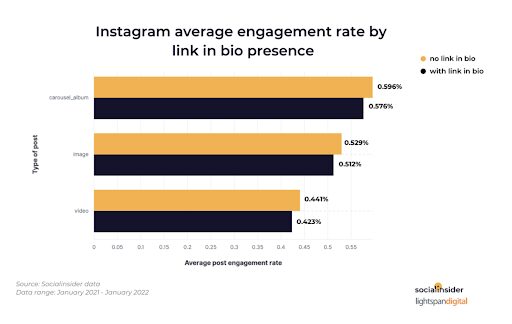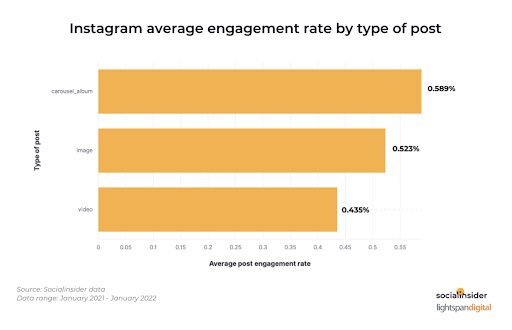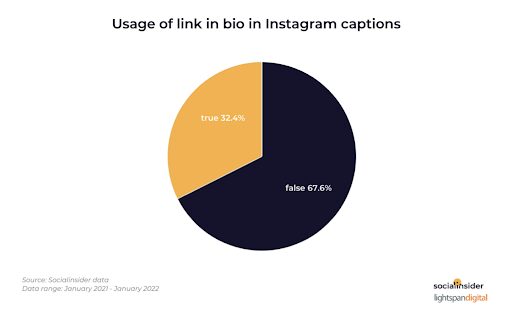As a social media professional, it is always a challenge to choose between creating a well-performing social media post and driving visitors to the website. However, as we have seen in our Facebook study, which analyzed link placement in posts, where we place a link can impact post reach and engagement. What about Instagram: does saying “link in bio” in a caption affect Instagram post performance?
Instagram is quite different compared to Facebook as a medium. Links in Instagram captions are (still) not clickable, discouraging brands and creators from sending people to an external website from posts in feed.
While Instagram allows links in stories, stories are ephemeral. Outside of stories, Instagram allows just one permanent link – on your profile page, also known as your “bio.” This has led to Instagram accounts adding a “link in bio” phrase to their captions when they want to use a post to drive visitors to a particular page on a website.
Some definitions you might need before we get into the meat of the study:
- Engagement is the sum of interactions that an Instagram page receives, including likes and comments.
- The average engagement rate per post, adjusted for the number of page followers, was found by taking the sum of interactions of one page and dividing them by the sum total of posts published by the page. The result is then divided by the number of page followers and multiplied by 100 for the rate. The final result can then be compounded and divided by the number of profiles analyzed for an average rate.
- Brand accounts: these are accounts that have selected the business account type option
Is it worthwhile to have a “link in bio” in Instagram captions?
For Instagram account managers, this may be a common source of frustration. If the account’s bio link needs to be updated frequently, it becomes a pain. Instagram work is time-consuming as it is.
There are solutions to place multiple links tied to one link in the bio. Our favorite tool is Taplink. It is a robust tool that allows you to create a mini jump website and display content such as links, images or buttons, videos, and more.
Regardless, compared to just placing a link in a post as you can on other platforms, the Instagram “link in bio” method creates a longer path for the user. A longer path means less usage. And despite users asking for the feature, Instagram is not budging, and we predict they won’t change their stance.
This case study takes a closer look at the pros and cons of using Instagram feed posts to drive visits to a website.
-
Instagram posts without “link in bio” in the caption perform slightly better than posts that include it.
An analysis of 78,662,277 Instagram posts showed that if accounts do not add “link in bio” in the caption, the post can gain as much as 0.38% more engagement than the post with that phrase (0.596% compared to 0.576%). This is true for carousels, the best-performing type of post on Instagram platforms, comprising 19.44% of current Instagram posts.
For image posts, if the account adds a “link in bio” phrase in the caption, engagement goes down from 0.529% to 0.512%. Video posts see a similar drop, from 0.441% to 0.423%.
Is this a relevant drop in engagement? Compared to Facebook engagement rates, not really. On Facebook, album post engagement rates would drop from 0.53% to 0.30% if a link was in the caption or as an attachment. An image post with a link in the caption would see a drop in engagement rate from 0.51% to 0.25%. By comparison, the decline in engagement for an Instagram post is negligible.
So, should you still add the phrase “link in bio” in your Instagram captions?
There are two ways to look at it. Instagram wants to keep people on their platform, which is why links are not clickable in their captions. This is also why posts that say “link in bio” may perform worse. But Instagram knows that allowing links only in bio will decrease the rates at which users leave the platform. This might be the reason why post performance rate is not heavily affected by the words “link in bio.”
When you decide whether or not to include “link in bio” in your caption, also consider your click-through rates. Does the CTR value offset the drop in engagement?
How can you ensure that your Instagram posts get the best possible performance, even if you need to place “link in bio” in the caption?
Let us take a look at the following insight.

-
Carousel posts on Instagram have the highest engagement rate, at 0.58% per post on average.
An effective way to boost your account’s performance rate without turning it into an ad or a boosted post is to use the post type that already performs the best on Instagram.
That’s the carousel post, which has a horizontal swipe-through. In fact, if the user does not swipe horizontally on the post, it often reappears on their feed with a photo they have not yet seen. There are multiple creative ways you can make use of carousel posts.
By defaulting to this post type, you can lessen your post’s slight disadvantage if there is a “link in bio” phrase in the caption.
How much better do carousel posts perform on Instagram?
On average, a carousel post receives a 0.589% rate of engagement. Images come next, with 0.523% engagement, and videos are last at 0.435%. However, videos generate the most comments.

In conclusion, use carousels to maximize performance, especially if you use “link in bio” in your caption.
-
Only 32.4% of Instagram business accounts use “link in bio” in their captions.
Instagram is almost 12 years old (launched in 2010), and it has never had clickable post links. Most of us are used to this. Your audience may automatically visit your profile page to check if there is a shop or a way to support your organization.
This survey of over 78 million Instagram posts shows us that only 32.4% of the brands, or 1 in 3 brand accounts, place the “link in bio” phrase in their caption. This might be because brands depend on user familiarity with the platform to bring them to their bio. Another reason might be that brands use their social media accounts for brand awareness and engagement rather than to drive traffic.
At the same time, 32.4% is a relatively high number. If we look at brands who put the links in their Facebook posts’ pinned comments, less than 1% go that route. Possibly because Facebook posts do not show the first comment on mobile.

When Facebook came about, it was optimized for desktop. Instagram, developed much later, was developed exclusively for mobile. To click through to a brand profile on Instagram is quite simple if a user wants to open the link, and it takes only a little backtracking to get back to their feed. Facebook is simply not designed this way, so the tactics are hard to compare.
Many tools are now available to brands that want to offer multiple destinations via the one link in their bio. Some tools collate various pages from the website or lead to a menu of options. This is an excellent way to maintain a link in bio without updating it with each post. Our favorite tool is Taplink.
However, the most important detail to remember is that it’s essential to have a link in your bio. It gives your page credibility and drives a certain level of traffic to your website.
Methodology
Analysts studied 92,724 Instagram business accounts and surveyed a total of 78,662,277 posts between January 2021 to January 2022. Each profile had at least 1,000 followers.
They wanted to understand if a “link in bio” caption phrase influences the performance of Instagram feed posts. They:
- Compared the performance of posts with and without the phrase,
- Calculated the percentage of posts that used this phrase in their captions, and
- Discovered the Instagram post type that performs the best regardless of a “link in bio” phrase in their caption.
Their key findings, to summarize, are as follows:
- Instagram posts without “link in bio” in the caption perform 0.38% better than posts that include it
- Carousel posts on Instagram have the highest engagement rate, of 0.58% per post on average
- The “link in bio” caption is something that only 32.4% of brand accounts actually do
Because the link is still important to drive traffic to the website, one possible strategy is prioritizing carousel posts to offset the disadvantage of mentioning a “link in bio” in the caption.
Conclusion
The phrase “link in bio” should be familiar enough to users that any brand account can use it without distracting the users from the content of either the image or the caption.
Previously, some social media marketers speculated that the algorithm restrains the performance of posts that mention a link in bio. Now, based on 78 million posts, we know that the best-performing post type, a carousel, can do up to 0.38% better if it does not say “link in bio.” At the same time, the difference is not significant enough to discourage brand accounts from pointing to their bio from their posts.
Keep in mind that the algorithm looks at more than just one phrase to bring users the content it deems best fitted for them. The algorithm is user-oriented and platform-oriented. If you produce valuable content that your audience loves, the algorithm will continue to reward it.
Give yourself enough space to strategize, experiment with link placements, and see how it affects your own engagement rate!

Leave a Reply